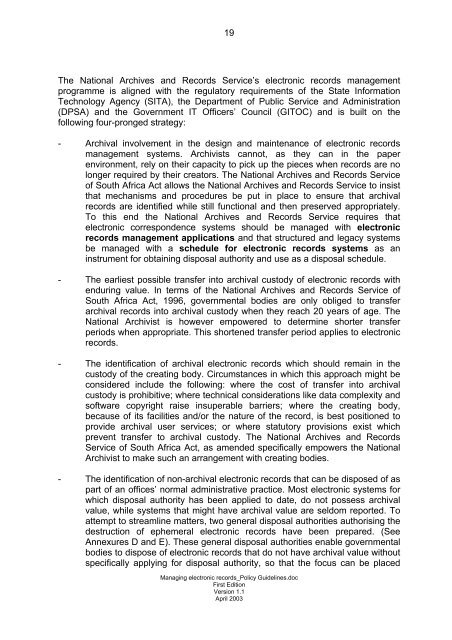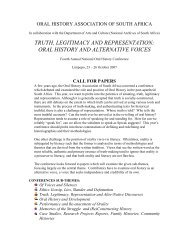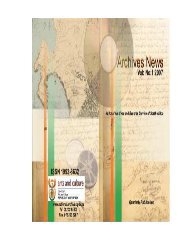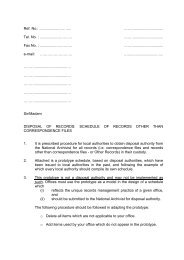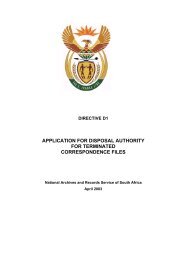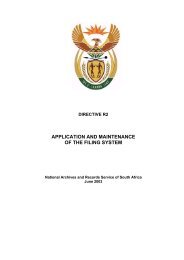managing electronic records in governmental bodies - National ...
managing electronic records in governmental bodies - National ...
managing electronic records in governmental bodies - National ...
You also want an ePaper? Increase the reach of your titles
YUMPU automatically turns print PDFs into web optimized ePapers that Google loves.
19<br />
The <strong>National</strong> Archives and Records Service’s <strong>electronic</strong> <strong>records</strong> management<br />
programme is aligned with the regulatory requirements of the State Information<br />
Technology Agency (SITA), the Department of Public Service and Adm<strong>in</strong>istration<br />
(DPSA) and the Government IT Officers’ Council (GITOC) and is built on the<br />
follow<strong>in</strong>g four-pronged strategy:<br />
- Archival <strong>in</strong>volvement <strong>in</strong> the design and ma<strong>in</strong>tenance of <strong>electronic</strong> <strong>records</strong><br />
management systems. Archivists cannot, as they can <strong>in</strong> the paper<br />
environment, rely on their capacity to pick up the pieces when <strong>records</strong> are no<br />
longer required by their creators. The <strong>National</strong> Archives and Records Service<br />
of South Africa Act allows the <strong>National</strong> Archives and Records Service to <strong>in</strong>sist<br />
that mechanisms and procedures be put <strong>in</strong> place to ensure that archival<br />
<strong>records</strong> are identified while still functional and then preserved appropriately.<br />
To this end the <strong>National</strong> Archives and Records Service requires that<br />
<strong>electronic</strong> correspondence systems should be managed with <strong>electronic</strong><br />
<strong>records</strong> management applications and that structured and legacy systems<br />
be managed with a schedule for <strong>electronic</strong> <strong>records</strong> systems as an<br />
<strong>in</strong>strument for obta<strong>in</strong><strong>in</strong>g disposal authority and use as a disposal schedule.<br />
- The earliest possible transfer <strong>in</strong>to archival custody of <strong>electronic</strong> <strong>records</strong> with<br />
endur<strong>in</strong>g value. In terms of the <strong>National</strong> Archives and Records Service of<br />
South Africa Act, 1996, <strong>governmental</strong> <strong>bodies</strong> are only obliged to transfer<br />
archival <strong>records</strong> <strong>in</strong>to archival custody when they reach 20 years of age. The<br />
<strong>National</strong> Archivist is however empowered to determ<strong>in</strong>e shorter transfer<br />
periods when appropriate. This shortened transfer period applies to <strong>electronic</strong><br />
<strong>records</strong>.<br />
- The identification of archival <strong>electronic</strong> <strong>records</strong> which should rema<strong>in</strong> <strong>in</strong> the<br />
custody of the creat<strong>in</strong>g body. Circumstances <strong>in</strong> which this approach might be<br />
considered <strong>in</strong>clude the follow<strong>in</strong>g: where the cost of transfer <strong>in</strong>to archival<br />
custody is prohibitive; where technical considerations like data complexity and<br />
software copyright raise <strong>in</strong>superable barriers; where the creat<strong>in</strong>g body,<br />
because of its facilities and/or the nature of the record, is best positioned to<br />
provide archival user services; or where statutory provisions exist which<br />
prevent transfer to archival custody. The <strong>National</strong> Archives and Records<br />
Service of South Africa Act, as amended specifically empowers the <strong>National</strong><br />
Archivist to make such an arrangement with creat<strong>in</strong>g <strong>bodies</strong>.<br />
- The identification of non-archival <strong>electronic</strong> <strong>records</strong> that can be disposed of as<br />
part of an offices’ normal adm<strong>in</strong>istrative practice. Most <strong>electronic</strong> systems for<br />
which disposal authority has been applied to date, do not possess archival<br />
value, while systems that might have archival value are seldom reported. To<br />
attempt to streaml<strong>in</strong>e matters, two general disposal authorities authoris<strong>in</strong>g the<br />
destruction of ephemeral <strong>electronic</strong> <strong>records</strong> have been prepared. (See<br />
Annexures D and E). These general disposal authorities enable <strong>governmental</strong><br />
<strong>bodies</strong> to dispose of <strong>electronic</strong> <strong>records</strong> that do not have archival value without<br />
specifically apply<strong>in</strong>g for disposal authority, so that the focus can be placed<br />
Manag<strong>in</strong>g <strong>electronic</strong> <strong>records</strong>_Policy Guidel<strong>in</strong>es.doc<br />
First Edition<br />
Version 1.1<br />
April 2003


